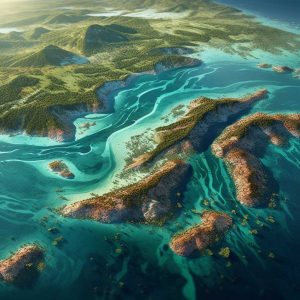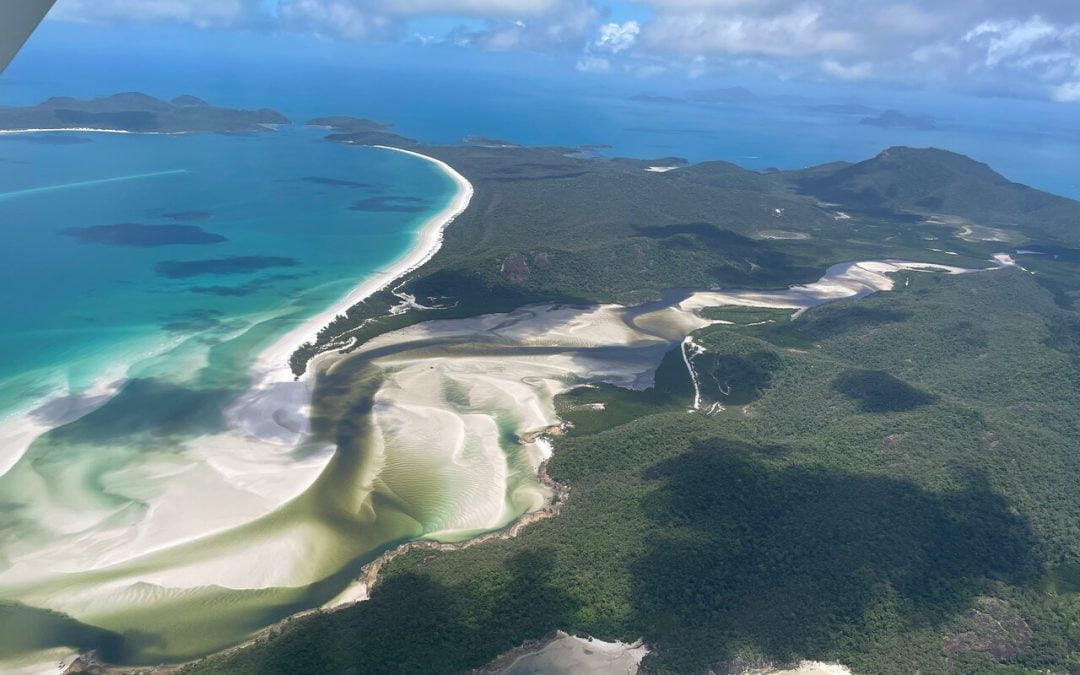Whitehaven Beach is a stunning natural wonder located in the Whitsunday Islands off Australia’s east coast. This beach is renowned for its brilliant white sand and crystal clear turquoise waters, which draw thousands of visitors to its shores every year.
The geological formation of Whitehaven Beach has been shaped by weathering and erosion, deposition and sedimentary processes over many years. The formation of Whitehaven Beach began with the weathering process, in which rocks are broken down into small pieces due to mechanical or chemical activity.
Over time, these smaller pieces were transported away from their original location through erosion caused by wind and water flow. As they moved along rivers and shorelines, large quantities of sediment were deposited on the sea floor creating new layers of material.
These new deposits then underwent further changes due to pressure from the above layers as well as chemical reactions caused by contact with seawater or groundwater. Whitehaven Beach was slowly formed over millions of years through these sedimentary processes until it became the stunning beauty we know today.
Weathering and Erosion:
Mechanical weathering is a physical process whereby rocks are broken down into smaller particles by the action of wind, water, ice, and/or temperature changes.
Chemical weathering occurs when minerals in rock react with oxygen in the environment to form new chemical compounds.
Both mechanical and chemical weathering processes contribute to the formation of Whitehaven Beach by breaking down large rocks and particles into finer-grained components, which can then be transported away by agents such as waves or wind.
Mechanical Weathering
Through the process of mechanical weathering, rocks are physically broken down into smaller fragments without changing their chemical makeup.
Temperature changes, wind, and water can all contribute to this process in different ways.
For example, when temperatures fluctuate from hot to cold or vice versa, it can cause rocks to expand and contract, eventually leading to cracking and breaking apart of the rock.
Wind and rain help by continually hitting the rock surface with pressure that causes small pieces to be worn away or broken off.
In addition, water has a powerful erosive effect on rocks due to its ability to move sediment around as well as break down minerals over time.
All of this contributes to the physical disintegration of rocks that is essential for the formation of Whitehaven Beach.
Chemical Weathering
Chemical weathering involves the decomposition of rocks and minerals through chemical reactions with elements in their environment.
Examples of chemical weathering on Whitehaven Beach, Australia, include:
- Oxidation: This occurs when oxygen in the air reacts with iron-bearing minerals in the sandstone, resulting in an orange hue to the beach.
- Hydrolysis: This occurs when rainwater reacts with certain minerals, such as feldspar or quartz, causing them to dissolve or be converted into different minerals.
- Carbonation: This is a reaction that takes place when carbon dioxide from the atmosphere dissolves into rainwater, making it more acidic and able to break down calcium-based minerals found in some rocks and soils.
The combination of these processes over time leads to changes in texture and composition of rock structures on Whitehaven Beach which can alter geological formations like cliffs, valleys, and caves.
Chemical weathering can also play an important role in shaping landscapes by eroding away softer materials faster than harder ones.
Erosion
Water erosion is a significant factor in the geological formation and reshaping of landscapes.
Whitehaven Beach in Australia, for example, is the result of thousands of years of wind and water erosion which has carved the shape of the beach in a curve like a smile,
The high energy waves caused by strong winds have further shaped the beach’s landscape by cutting through the northern headland.
Water Erosion:
Powerful waves continually shape the coast, eroding cliffs and depositing sediments to create a new landscape. At Whitehaven Beach, the effects of water erosion are particularly visible with:
- Southern beach rocky outcrops along the shoreline that have been carved by water action
- The deposition of sands at the base of the islands lush bushland a distinctive beach gradient
- A continuous reshaping of the coastline as wave energy works against beaches and headlands alike
These processes help to form the unique geological features found on Whitehaven Beach, creating an ever-changing landscape that is constantly being shaped and modified by erosion.
As this process continues over time, it helps to ensure that no two visits are ever quite the same – making Whitehaven Beach one of nature’s most dynamic creations.
Deposition and Sedimentary Processes
Deposition is laying down materials on a surface, which can be done naturally or artificially.
Sedimentary rocks are formed from the accumulation of sediment over time, and often contain fossils that provide information about past ecosystems.
The deposition and formation of the silica sand at Whitehaven Beach is thought to have been driven by wind and wave processes from further away, leading to its unique sand composition and beach features without evidence of quartz
Deposition
 The accumulation of eroded materials transported by natural forces have created the stunning landscape of this coastal area.
The accumulation of eroded materials transported by natural forces have created the stunning landscape of this coastal area.
Deposition is a significant process in the formation of Whitehaven beach, situated along the east coast of Australia.
This process occurs when sediments transported by wind or water settle in a new location and gradually build up over time.
The sediments that make up Whitehaven beach are derived from quartz rocks found in far away areas, which are then carried to the shore by waves.
Over time, these deposits accumulate and form distinct layers.
These layers often contain fossils that give insight into past environments and geological events.
Furthermore, sedimentary particles can be sorted through natural processes such as sorting according to size or movement patterns due to currents or tides, eventually forming distinctive features such as sand ridges or bars on the beach surface.
All these factors combined results in Whitehaven Beach possessing its iconic white sandy beaches so beloved by visitors today.
Sedimentary Rocks
Through the compaction and cementation of these sediments, sedimentary rocks are gradually formed.
They occur in a wide range of sizes and shapes, from small pieces to large structures.
The process of formation involves several steps: first, the sediment is compacted by pressure due to overlying layers; then, minerals are added, binding the particles together; finally some minerals may dissolve or be dissolved to form a solution that fills pores between particles and binds them together.
At Whitehaven Beach, the majority of the sediment consists of silica grains which contribute to its characteristic powdery white sand.
Through long-term compaction and cementation processes, these sediments become solidified into rock strata.
These sedimentary rocks have been exposed by wave erosion along shorelines resulting in beautiful pristine beaches such as Whitehaven Beach.
Example
Engulfed by the power of the tides, Whitehaven Beach is an awe-inspiring testament to the Earth’s dynamic processes.
In particular, the Whitsunday Islands and the Coral Sea provide a vivid example of geological formation.
Waves and currents continually shape and reshape the shoreline over time, eroding rocks and depositing sediments.
This combination of weathering, erosion, and sedimentation processes has led to Whitehaven Beach’s mesmerizing landscape.
The result is a stunning display of nature’s raw beauty that serves as a reminder of how powerful our planet can be.
Conclusion
The geological formation of Whitehaven Beach is a testament to the power of nature. It has been shaped by millions of years worth of weathering and erosion, as well as sedimentary processes like deposition.
The result is a stunning array of pristine white sand, clear blue waters, and ancient rocks that have been carved away over time. This beach serves as an example of how natural forces can shape our landscape in ways we may never understand fully.
By meditating here, we gain insight into the beauty and strength of nature’s timeless power. As the saying goes, ‘A picture speaks a thousand words’, which could not be more true regarding Whitehaven Beach – its unique geological formation truly captures the eye and stirs the soul in one lasting image.
Hi, I’m Nath J, a long-time local who’s been lucky enough to live and work tourism in the Whitsundays since 2001.
Over the past two decades, I’ve helped visitors discover the best of this incredible region, from Whitehaven Beach and Hill Inlet to the hidden spots only locals know about. I started out managing boats and tours, and these days I run Ripple Effect Online, a tourism-focused digital marketing business helping local operators grow and connect with travellers like you.
I’ve written an ebook called Whitsunday Islands: A Journey through Paradise, created countless local travel guides, and earned recognition as a “Whitsundays Tourism Hero” from QTIC for my contribution to the region and gained First Nations Cultural Protocol training through QTIC as well. But more importantly, I’ve spent years listening to travellers, understanding what makes a trip unforgettable, and helping people plan the kind of experience they’ll talk about for years.
If you’re planning a visit to Whitehaven Beach or anywhere in the Whitsundays, I’m here to help you make it amazing.
Find me on Facebook and LinkedIn or drop me an email at info@nath-j.au.

